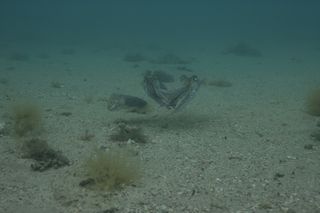Vicious Cuttlefish Fight Captured on Video for 1st Time

Flashing colors, aggressive postures, spurts of bodily fluids: Fights this graphic usually show up only on pay-per-view.
In a new video, two male common cuttlefish (Sepia officinalis) tussle over a mate, though "tussle" doesn't quite do it justice. The feisty cephalopods barrel roll, bite and squirt jets of black ink in an undersea battle that had never been caught on film until now.
"It was amazing, and there was so much ink everywhere," said Justine Allen, an adjunct instructor in ecology and evolutionary biology at Brown University, who witnessed the cuttlefish battle as a doctoral student in neuroscience at the university. The violent behavior was a rare moment to witness, she told Live Science. [See Video of the Vicious Cuttlefish Fight]
"It's pretty unusual for them to accelerate up to biting and twisting and grappling, and all the ink and all of the more aggressive behaviors we saw," Allen said.
Battle royal
Allen and fellow scientist Derya Akkaynak of the University of Haifa in Israel were diving in the Aegean Sea off the coast of Çeşmealtı, Turkey, for a project investigating the properties of cuttlefish camouflage. These squishy cephalopods can rapidly change their skin patterns with altering-pigmented organs called chromatophores. The researchers were filming a lone female, planning to measure the light spectra bouncing off her skin, when a male cuttlefish approached, and — without any foreplay — swooped in to mate with the female in the head-to-head position that cuttlefish use. The male then hovered over the female, guarding her from rivals.

After only about 3 minutes, one appeared. A second male darted in and flashed a dark zebra pattern at Male No. 1, a known sign of cuttlefish aggression. The intruder also extended his fourth arm, another aggressive signal. Male No. 1 returned these signals and then turned dark and fled, inking in alarm. [See Photos of Colorful, Camo-Wearing Cuttlefish]
It looked like a victory for Male No. 2, who placidly took his place above the female and began swimming along. Just over a minute later, though, Male No. 1 returned to defend his honor and reclaim his mate. He challenged his rival, flashing dark colors, darting around and inking for about 10 seconds, until Male No. 2 decided to grab onto the female and attempt to mate. At that point, Male No. 1 grabbed the interloper and all three cuttlefish ended up in a confused tangle of tentacles.
Sign up for the Live Science daily newsletter now
Get the world’s most fascinating discoveries delivered straight to your inbox.
High-stakes conflict
The female quickly broke away and fled the scene, leaving Male No. 1 with a death grip on Male No. 2. The first male barrel-rolled his rival three times as the two inked and bit one another viciously. Though males have been observed fighting over females in captivity, this fight in the wild was far more violent than what has been seen in laboratory tanks, Allen and her colleagues wrote May 2 in the journal American Naturalist.

After a few seconds of outright brawling, Male No. 2 broke away and fled, with the first male giving a short chase. Male No. 1, now the victor, returned to the female and the two returned to their post-coital swim. The interloper male did not return for the rest of the researchers' dive.
As all this was going on, Allen and Akkaynak were frantically trying to catch every moment on video. At one point, Akkaynak shoved a still camera at Allen, Allen said, which was flashing some sort of error message about disk space and whether it should override previous data.
"I was like, 'Yes, fine, whatever, yes, okay, I don't care if this overwrites our research data,'" Allen said.
Though the encounter was more violent than fights observed in captivity, the postures and aggression seen in the wild confirmed that captive cuttlefish communication is similar to what happens in the open ocean, Allen said. Among the cuttlefish's stranger aggressive signals is its ability to independently dilate one pupil for extra intimidating stare-downs.
"It's kind of creepy," Allen said.
The males in the conflict seemed to be gauging their fighting ability against one another, escalating the battle gradually from intimidating displays to all-out fighting. Cuttlefish generally prefer not to make contact with one another if they can help it, Allen said, because fighting can lead to scarring; these skin scars can interfere with the cuttlefish's camouflage and visual communication. That's one reason it was surprising to see two cuttlefish going at it.
"I think it's just reflective of how fierce the competition is for mates," Allen said.
Original article on Live Science.

Stephanie Pappas is a contributing writer for Live Science, covering topics ranging from geoscience to archaeology to the human brain and behavior. She was previously a senior writer for Live Science but is now a freelancer based in Denver, Colorado, and regularly contributes to Scientific American and The Monitor, the monthly magazine of the American Psychological Association. Stephanie received a bachelor's degree in psychology from the University of South Carolina and a graduate certificate in science communication from the University of California, Santa Cruz.
Most Popular


